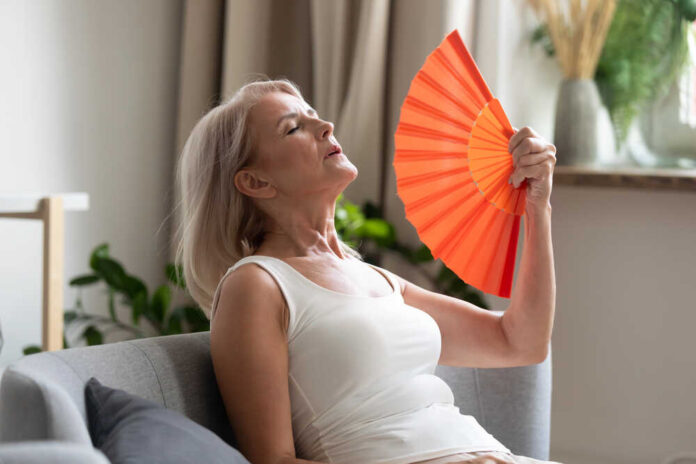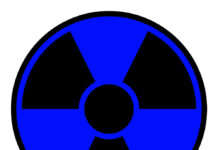
(GoHealthier.com)
If you are a menopausal or perimenopausal woman, you may know that horrendous and all too familiar feeling of sudden and intense heat known as a hot flash. Hot flashes can cause flushing, sweating, increased heart rate, and chills afterward, lasting anywhere from 30 seconds to several minutes. They can be embarrassing and even debilitating, particularly when they disrupt sleep. But what causes this terrible side effect of menopause, and what, if anything, can be done to treat it?
Hot flashes are primarily caused by changes in hormone levels, particularly the decline in estrogen that occurs during menopause. However, the exact mechanism is complex and not fully understood. Here’s a breakdown of the key factors that contribute to hot flashes:
1. Hormonal Changes:
• Estrogen Decline: As women approach menopause, their ovaries produce less estrogen, which disrupts the body’s temperature regulation. Estrogen plays a role in the hypothalamus, the part of the brain that controls body temperature. A decline in estrogen can cause the hypothalamus to become more sensitive to slight changes in body temperature.
• Thermoregulatory Dysfunction: The hypothalamus might mistakenly perceive the body overheating, triggering mechanisms like dilating blood vessels (causing flushing) and sweating to cool the body down.
2. Changes in Blood Vessels:
• Vasodilation: During a hot flash, blood vessels near the skin’s surface widen (vasodilation) to release heat, leading to the sensation of warmth and visible flushing.
• Sweating: This is the body’s natural cooling response, which helps to lower the body’s core temperature.
3. Neurochemical Changes:
• Neurotransmitters: Fluctuations in neurotransmitters like norepinephrine and serotonin, which also regulate body temperature, may contribute to hot flashes. These changes might make the body’s temperature regulation more erratic.
4. Triggers:
• External Factors: Certain foods (spicy foods, hot drinks), beverages (alcohol, caffeine), stress, smoking, and even warm environments can trigger hot flashes in some people.
• Lifestyle: Lack of physical activity, obesity, and certain medical conditions can also exacerbate hot flashes.
5. Other Influences:
• Age and Menopause: Hot flashes are most common during perimenopause and menopause but can also occur due to other factors like certain medications, medical treatments (like chemotherapy), or surgical removal of the ovaries.
• Genetics: Some women are more prone to hot flashes due to their genetic makeup.
6. Medications and Health Conditions:
• Certain Medications: Drugs that affect hormone levels, such as tamoxifen (used in breast cancer treatment) or some antidepressants, can trigger hot flashes.
• Health Conditions: Conditions like thyroid disorders, infections, or certain cancers can also cause symptoms similar to hot flashes.
Understanding the underlying causes of hot flashes is key to managing them effectively. Hormone replacement therapy (HRT) and non-hormonal treatments can help reduce their frequency and severity by addressing the hormonal and neurochemical imbalances that contribute to their occurrence. Here are the top 8 most effective ways to combat hot flashes:
- Hormone Replacement Therapy (HRT):• Estrogen Therapy: The most effective treatment for hot flashes, especially when symptoms are severe.
• Combined HRT: Includes both estrogen and progestin, typically used for women who still have their uterus.2. Non-Hormonal Medications:
• Antidepressants: Certain SSRIs and SNRIs like venlafaxine and paroxetine can reduce hot flashes.
• Gabapentin: Originally used for seizures, it can also help manage hot flashes.
• Clonidine: A medication primarily used for high blood pressure, it can also reduce hot flashes for some women.3. Lifestyle Changes:
• Cool Environment: Keep your living spaces cool and use fans or air conditioning.
• Layered Clothing: Wear layers to adjust your clothing as needed.
• Dietary Adjustments: Avoid hot drinks, spicy foods, caffeine, and alcohol, which can trigger hot flashes.
• Stress Management: Practices like yoga, meditation, or deep breathing can help reduce the frequency and severity of hot flashes.4. Herbal Remedies and Supplements:
• Phytoestrogens: Found in soy products and flaxseeds, these plant-based estrogens may help some women.
• Black Cohosh: A popular herbal supplement that some women find effective, though scientific evidence is mixed.
• Vitamin E: Some studies suggest it may reduce the frequency of hot flashes, though the effect is generally mild.5. Acupuncture:
• Some women find relief from hot flashes through acupuncture, though results can vary.
6. Cognitive Behavioral Therapy (CBT):
• CBT can help women manage the emotional and psychological impact of hot flashes, which may indirectly reduce their frequency.
7. Avoiding Triggers:
• Identify Triggers: Keeping a symptom diary to track what might trigger your hot flashes can be helpful.
• Reduce Stress: Emotional stress can exacerbate hot flashes, so stress reduction techniques can be beneficial.8. Weight Management:
• Maintaining a healthy weight can help reduce the frequency and intensity of hot flashes. Obesity has been linked to more severe hot flashes.
While these strategies can significantly reduce or manage hot flashes, completely eliminating them might not always be possible. However, many women find that their symptoms gradually improve over time. It’s important to discuss treatment options with a healthcare provider to find the best approach for your situation.
Copyright 2024, GoHealthier.com














